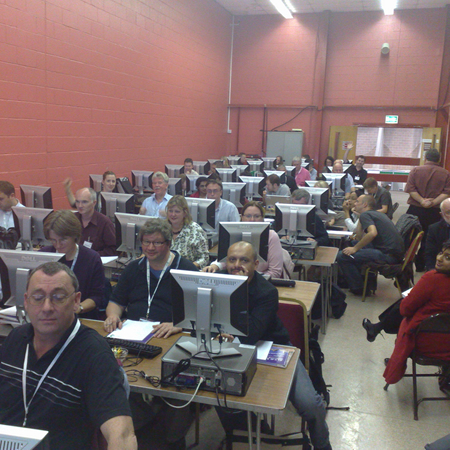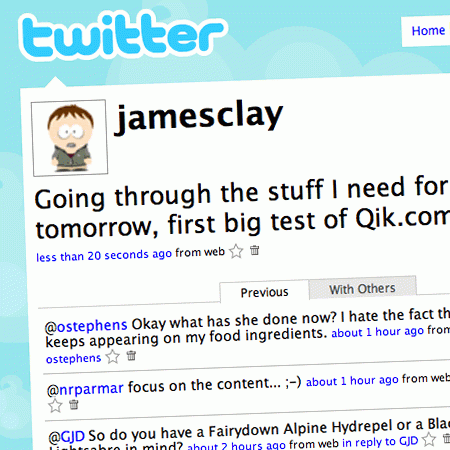Introduced to a funky little Twitter tool today called Tweet 3D.![]()
So entered my Twitter username and, well this video says it all really!
Introduced to a funky little Twitter tool today called Tweet 3D.![]()
So entered my Twitter username and, well this video says it all really!
I do the Twitter.
One of the things about Twitter is the interconnections between different people on Twitter. Tweetwheel allows you to show who follows who via a very nice graphical wheel.
View my “proper” interactive Tweetwheel here. It was interesting for me to find out that though I follow a fair few people, they rarely follow the same people I follow. There is some interconnectivity, but not as much as I thought.
Found this, reminded me of the Digital Divide Slams from ALT-C 2008.
[audio:http://elearningstuff.files.wordpress.com/2008/09/5090-14-youre-no-one-if-youre-not-on-twitter.mp3]You’re No One If You’re Not On Twitter by JB Walker is licensed under a Creative Commons Attribution-Noncommercial-Share Alike 2.0 UK: England & Wales License.
I ran a workshop at ALT-C yesterday morning on Web 2.0 though didn’t have time to blog about it yesterday.
Session seemed to go well though I did have about sixty people in a long narrow room.

The feedback from the session can be found here:
http://altcworkshop.blogspot.com/
Please feel free to add comments to people’s blog posts.
Other stuff from the workshop can be found on
Flickr
http://flickr.com/photos/jamesclay
Qik
Seesmic
Jaiku
http://molenet.jaiku.com/
Recorded Gabcast podcasts from my sessions at #altc2008 today. They are online now at http://tinyurl.com/hood2feedback
A few comments from other people’s blogs and links mentioned as part of feedback.
http://www.projectwhite.com/tag/altc2008/
http://www.scribd.com/doc/2286799/Can-we-use-Twitter-for-educational-activities
http://onlinejournalismblog.com/2008/04/04/live-reviewing-a-book-on-twitter-here-comes-everybody-by-clay-shirky/
and here’s a reflection
http://onlinejournalismblog.com/2008/04/07/twitter-reviewing-some-reflections/
http://ashleywright.org/2008/09/09/hood-20-its-a-web-20-world/
http://www.projectwhite.com/tag/altc2008/ – loads of stuff , excellent
Thanks everyone, some great feedback and ideas.
I am running two workshops at ALT-C 2008 next week, one on mobile learning and the other on Web 2.0.
Hood 2.0: it’s a Web 2.0 world out there
This workshop will explore how using Web 2.0 can rethink the digital divide.
Gloucestershire College has been using Web 2.0 to enhance and enrich the learning process for a wide variety of learners across the breadth and depth of the curriculum. They have developed a range of learning scenarios and activities that are integrated into the learning process and support a diverse range of learners.
This workshop will demonstrate how Web 2.0 can be used to solve some of the issues facing diverse learners in this era of Facebook. YouTube, Twitter and then some…
The concept of Web 2.0 services in addressing the tensions between formal and informal learning, and empowering learners to take responsibility for their own learning will be examined. Then, how we need to address the pedagogical needs to drive the use of Web 2.0 services and not be blinded or awed by the technology of Web 2.0, will be explored.
During the workshop participants will be able to discuss and debate different learning scenarios and activities which utilise Web 2.0 services. Web 2.0 services will be used to demonstrate these scenarios.
Participants will discuss and debate these scenarios in small groups, covering how they could be utilised within their own institutions, examining the potential conflict between formal learning scenarios and the informal learning scenarios that Web 2.0 offers.
The groups will also discuss how the pedagogy needs to drive the scenarios and not the technology and address how Web 2.0 can empower learners to take responsibility for their own learning. Each group will provide feedback through either a blog entry, an audio podcast or a video presentation. These will then be made available online to allow participants to comment and continue the discussion beyond the workshop, and also allow other conference delegates to participate in the discussion.
After the workshop, the participants will have a greater understanding of the role of Web 2.0 in addressing the digital divide.
They will have considered how Web 2.0 can help resolve the tensions between formal and informal learning; discussed how Web 2.0 technologies in themselves mustn’t drive the learning, but support the pedagogy; and debated how Web 2.0 can empower learners to take responsibility for their learning.
The participants will have presented the results of their discussion and debate, through the use of a variety of learning technologies, to other participants and to other conference delegates.

This is the second e-Learning Stuff Podcast, Stuff.
e-Learning Stuff Podcast #002 – Stuff
Subscribe to the podcast in iTunes.
Shownotes
Some of you may follow me on Twitter (or Jaiku) and will know I flit around the South-West and sometimes further afield.
Looks like there’s a new Twitterer to follow and they’re on Mars.

Nasa are using Twitter (amongst other web tools and sites) to update people on what the Pheonix Mars Lander is doing on Mars.

This to me illustrates another way in which micro-blogging tools can be used to provide information and interesting stuff to learners.
One of the features of Twitter is that the tweets are available as an RSS feed and therefore can be fed into a browser or into a VLE (such as Moodle).
For some reason how much coffee I drink is becoming something of an in-joke on Twitter. Personally I thought I don’t talk about coffee that much do I?
Well I was wrong.
According to my Tweetcloud it would appear that I do drink a lot of coffee!

Ah well time to talk about something else, anyone for a cup of tea?
Nice article on some of the academic uses of Twitter which I found out about after reading a blog entry on Twitter from Lindsay Jordan.

The article by Dave Parry says:
I thought I would explain how I use it, specifically for academic related uses, and teaching.
Includes a really interesting observation on the way that learners used Twitter for classroom chatter.
The first thing I noticed when the class started using Twitter was how conversations continued inside and outside of class. Most of these conversations were not directly related to class material, but many were tangentially related. Because the students had the shared classroom experience when something came up outside of class that reminded them of material from class time it often got twittered. This served as a reinforcement/connection between the material and the “real world.”
The whole article is well worth reading if you are wondering about the academic benefits of Twitter.
In case you are still wondering what Twitter is…
One thing about Twitter is that you need to “do it” to really understand it.
Many of these ideas would also work for Jaiku (and in some cases with the threaded commenting could work better).
I have always liked the Sony VAIO UX1XN.
I have always been disappointed with the battery life. My original intention was to use the UX1XN as my main conference computer, my first attempt was at the JISC digitisation conference in Cardiff back in 2007.
Here Brian Kelly is presenting…

It’s small enough to be unintrusive, unlike a laptop which can be a bit of a barrier, it has two cameras which enable me to send images to Flickr or take short video clips, and the keyboard is usable unlike the fiddly mobile phone type split keyboard of the Q1 Ultra. You can also use it without needing to put it on the table or on your lap which makes it ideal in the conference hall or break-out room environment.
However as I said at the beginning the battery life is the downer, I only really get about an hour and half from it, and this means that it won’t last the day at a conference.
So recently I ordered the extended battery for it, which should make it usable and hopefully last the day at a meeting or a conference.
I have therefore been practicing using the keyboard, which is quite thumbs orientated, and have managed to get a reasonable speed using it.
I wouldn’t want to write a long blog entry (like this one) on it, but for entering URLs or posting tweets or jaiku postings, I think it will work just fine.
Now of course what works well in the conference means that it would work equally well in the classroom or lecture theatre or workshop as a communication tool for learners.
Alas Sony no longer produce the UX1XN in the UK and though available from some suppliers still, generally you would need to get another UMPC if you were going to provide them to learners.